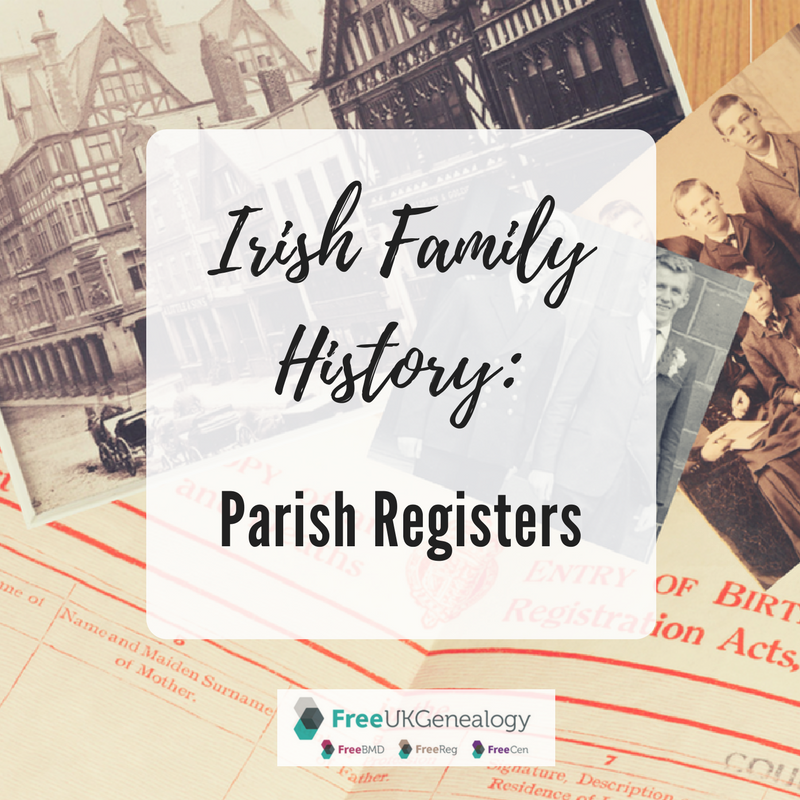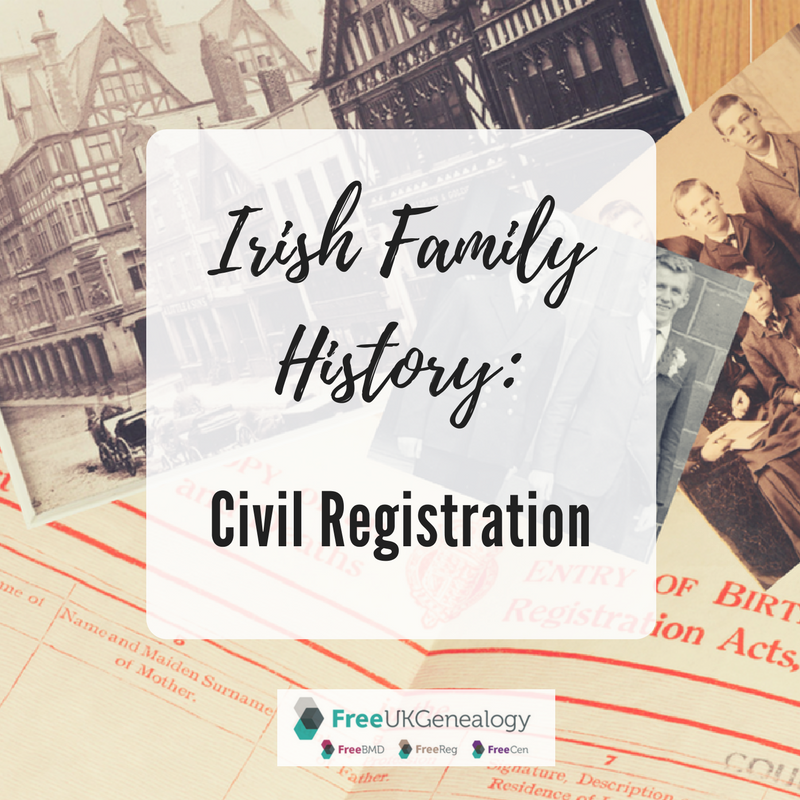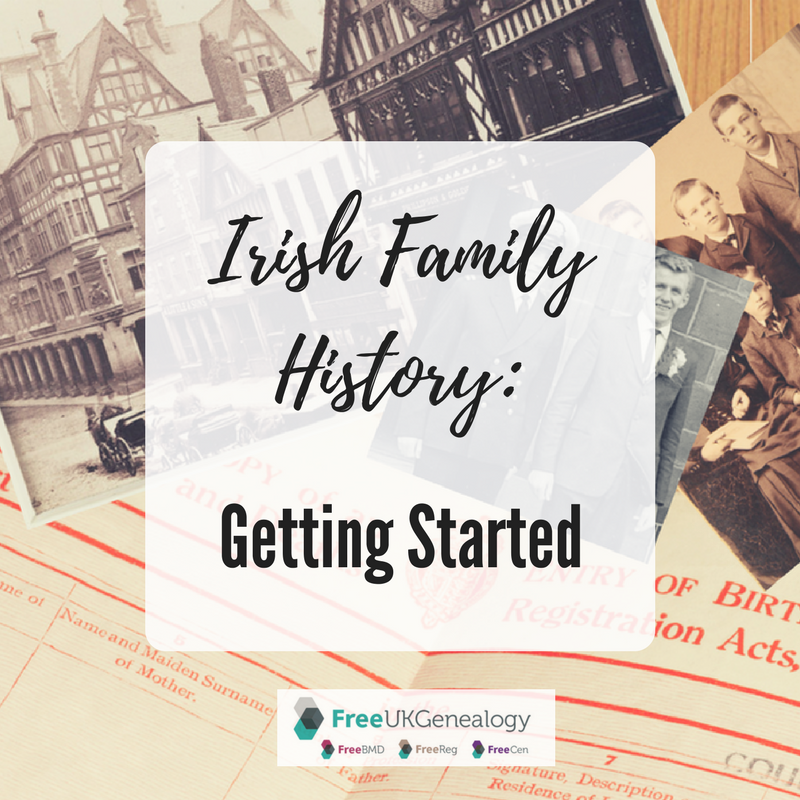Irish Family History: Census Returns
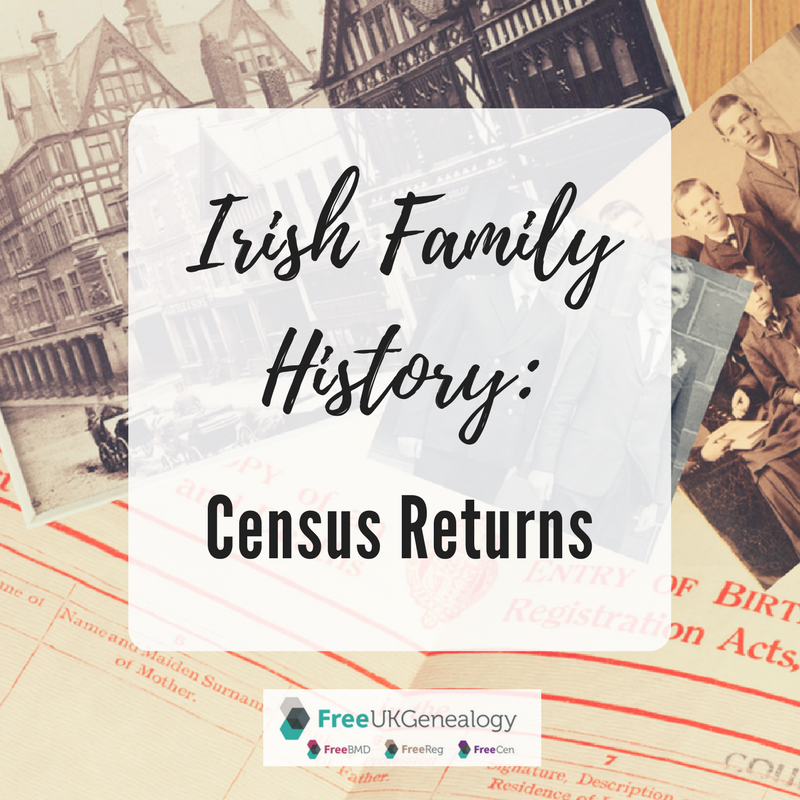
In the fourth post out of six on Researching Your Irish Family History, Nicola Morris explores the surviving Irish census returns, where to find them online and how to get the best out of the records.
NB: Ancestry and Find My Past are free to search, but require subscriptions to view records.
*****************************************************************************************
Have I already mentioned the destruction of the 19th century Irish census returns? This loss appears to be the basis for the erroneous belief that Irish genealogy is impossible.
Population censuses as we understand them today began in Ireland in 1821 and continued every decade until 1911. Unfortunately, the census returns from 1861 to 1891 were destroyed during the First World War, possibly because of a paper shortage. In the 1922 Public Records Office fire the returns from 1821 to 1851 were also largely destroyed. Only fragments of these early census returns survive. This means that the only complete surviving census returns for Ireland are for 1901 and 1911. However, as good genealogical miners, Irish genealogists know how to squeeze every last drop of information out of what survives.
The 1901 and 1911 census of Ireland returns have been freely published online by the National Archives of Ireland (http://www.census.nationalarchives.ie/), but before you start searching the census for your ancestor try to determine what you know about them, in order to set your search criteria...
Do you know the name of the person you are searching for?
Try to establish all of the different variants under which their name might be recorded. For example, Catherine Byrne could appear in the census as Kate, Katie, Kathleen or Katherine and Byrne might be recorded as Beirne, Burns or Byrnes.
Use wildcards
The search engine for the Irish census returns on the National Archives site requires an exact spelling and will not show variants of names. For this reason I will often search using wildcards. By searching for K*t* or C*t* B*rn* I should be able to see all possible variants of that name. Don’t underestimate the ability of your ancestors to use unusual spellings for first names.
Try swapping the forename and surname
The census was transcribed exactly as it appears on the original return. In some small cases, the head of household put the family surname in the first name field and the first names in the surname field. This means that the only way to find some families is to search for Byrne Catherine, rather than Catherine Byrne.
Check for initials
Inmates of workhouses, prisons and institutions as well as police constables in barracks, only appear in the census under their initials. If Catherine Byrne was in the workhouse on the night of the census, she would appear as C. or K. B. While you may find several entries for a C.B. in workhouse and institutional returns, other identifying information recorded on the census should help you to narrow down the field of your search. For example, are you looking for a C.B. who was a female, unmarried, age about 27, who was born in Carlow or a 68 year old widower who was born in Dublin? If Catherine had infant children with her in the workhouse, they may appear in the same return. Infants stayed with their mother, so should be enumerated just under her entry.
You might confirm the correct return if you find C.B. with a male infant J.B. (James Byrne).
It should be noted that policemen who were in the barracks on the night of the census and who were recorded by their initials only, listed their occupation not as constable, but the occupation they held at the time of their recruitment. Don’t dismiss a ‘farmer’ listed by his initials in a police barracks, he was most likely a constable who was a farmer prior to his recruitment.
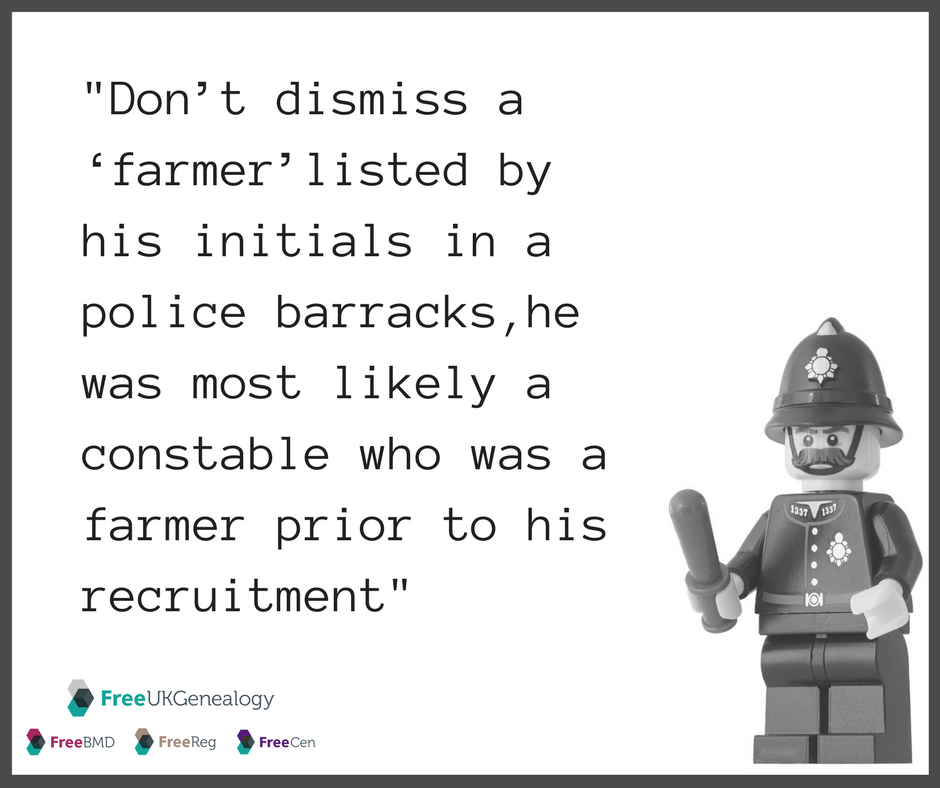
Bear in mind that ages given on census returns were not always accurate. As ages given in other sources may not be accurate either, it is always sensible to keep your search broad to start with. For example, the age recorded on a death certificate, particularly for someone who has died in advanced old age, may not be correct. The age was usually given by the informant and not the deceased and may be incorrect. The true age of the deceased individual may not have been known by their spouse or children. Ages given on the actual census return were usually given by the head of household, who may not have known his wife’s true age and thus given an incorrect age on the return. A man with a wife who was older than him, may have reduced her age to bring in into line with or below his own. The introduction of the old age pension between the 1901 and 1911 census encouraged older household members to advance their age to bring them closer to qualifying for the pension. The reason behind this is that when the pension was introduced, older members of the population born prior to 1864 when civil registration was introduced, could not provide a birth certificate as proof of age. Instead, they could request a search of the earlier census returns that would confirm their age in 1841 or 1851, thus meeting the age qualification for the pension.
While age is an important factor in identifying the correct census returns for your ancestor, do not rely on your ancestor giving the correct age on their census return.
Do you know your ancestor’s occupation?
Occupations were usually recorded on birth, marriage and death certificates. If your ancestor was a cabinet maker, teacher or nurse, you can use the ‘advance search’ section to search for all Byrnes who were teachers. However, it is important to bear in mind how that occupation might have been described. A teacher may have been described as a N.S. Teacher (National School Teacher) or a policeman may have been described as a policeman, constable or RIC. In some cases a person’s occupation may have changed, even between the 1901 and 1911 census, a labourer in one instance, may have gained employment as a cooper by the time of the next census. Usually, anyone who is described as a pensioner has retired from service with the constabulary, army or navy.
Do you know your ancestor’s religion?
The 1901 and 1911 census of Ireland recorded the religious denomination of the population. You might be looking for a Byrne family who were Church of Ireland rather than Roman Catholic and searching by religious denomination can help to narrow the field. If you are unsure of the religion of your ancestors, the census can be used to determine the religion of families with the same name. For example, searching for a particular surname in Co. Fermanagh might reveal that in nearly all instances persons with that name were Roman Catholic, when the assumption was that they were Church of Ireland. Determining the religious denomination of your ancestors in Ireland using the census will allow you to focus your research on specific church records.
Do you know when your ancestor was born and the age they might have been at the time of the census?
The search engine on the National Archives of Ireland website will list all entries with an age range five years either side of the age given in the search form. It is possible, once the results have been listed, to click on ‘Age’ and have the results listed in descending order from the youngest to the oldest, making it easier to focus on a specific age range.
Mine the records
I have already mentioned that Irish genealogists mine the census for every scrap of available information. When searching the census online, do not just make a note of the name, age and religion of the individuals, which is what you will see in your initial results. Click on the box: ‘show all information’. This will reveal the birthplace, occupation, literacy, marital status and language of the inhabitants as well as their relationship with the head of the household. The 1911 census also recorded the length of time a couple had been married, the number of children born to their marriage and the number of children alive in 1911.
The 1911 census return for Catherine Byrne at Baldonnell revealed that she was born in Dublin city ca. 1866. The presence of her brother, Peter Beatty, establishes her maiden name. She had been married for 25 years, indicating that she married ca. 1886 and she had given birth to 4 children, all of whom were living in 1911 but only three were living at home. It is now possible to search for the marriage of a Catherine Beatty to a Patrick Byrne, farmer, ca. 1886, most likely in a Roman Catholic parish in Dublin city, where Catherine was born.
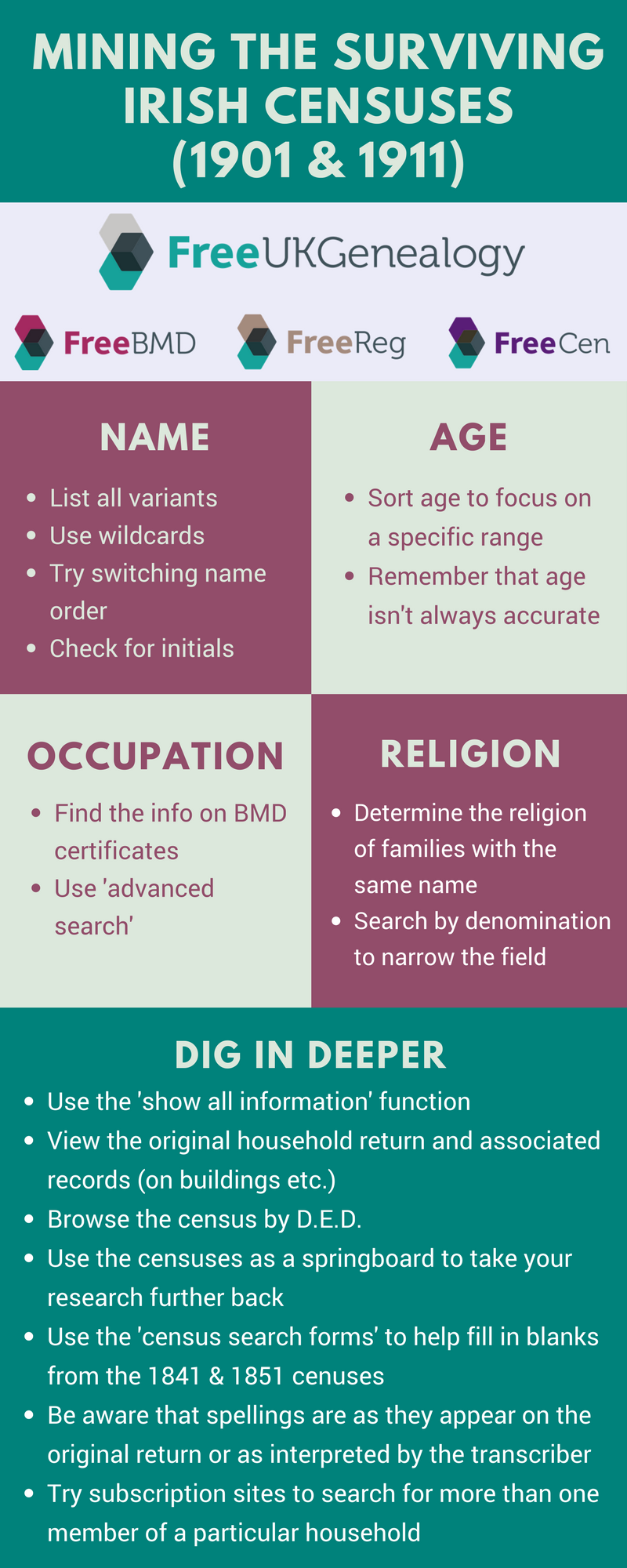
Below the transcribed information for each family, you will see links to ‘view census images’. Always view the original household return to make sure that the transcribed information is correct. In many instances it is not. The other images associated with the census can also be mined for information, particularly the House and Building Return (Form B1). This return will give you a description of the house your family occupied. The return will tell you how many rooms they occupied in the house, the materials from which the house was built and how many windows were at the front of the building as well as the number of out buildings or farm buildings on the property (which are described in more detail on the Out-Offices and Farm-Steadings Return Form B2). The House and Building Return will also give you a picture of all the households in a townland or on the same street and on occasion identify the landlord of the property. It is not uncommon, when inspecting the House and Building Return, to notice a cluster of families with the same surname listed one after the other. Are these families all related? Are they brothers or cousins who built their own houses on a single family plot? Is the widow living next door the mother of your ancestor, in her own house, on the same family plot?
Browse the census
If you know the address of your ancestor you can get an overview of the entire townland by browsing rather than searching the census. However, in order to browse you will need to know the District Electoral Division (DED) in which your townland is located. A shortcut to identifying the DED and the returns for a specific townland can be found on John Grenham’s website www.johngrenham.com. Search the Places section for your townland. When identified, and you open the page for the parish in which that townland is located, click on the 1901 or 1911 link. You will be brought to the census website, to the page relating to the DED in which your townland is located. You can then click on your townland and see the surnames of each household in the townland with a link to each household return. This route is helpful when you have failed to find your family even when you know their address. I have often looked at all of the occupiers of a townland and discovered that the family I was searching for were incorrectly recorded as O’Rogan, when I had been searching for Regans.
The 1901 and 1911 census of Ireland are springboards for most family history researchers. Finding your family in the census should tell you where and when they were born, when they married, the number of children of their marriage, their occupation, ability to read and write and religion, as well as the type of house they lived in and whether their neighbours might have been siblings or cousins. All of this information is freely available at http://www.census.nationalarchives.ie/.
On the same site you will also have the option to search the fragments that survive from the 1821, 1831, 1841 and 1851 census. Browsing this record set will demonstrate how little actually survives, but if you have family from Cavan you may find surviving 1821 returns, which can be searched by parish and townland as well as by surname.
One other remnant of the 19th century census returns that have been published online by the National Archives of Ireland are the census search forms. These are the forms used by applicants for the old age pension requesting a search of the 1841 and 1851 census for evidence of age. The forms include the name and current address of the applicant and usually their parents’ names and the name of the townland they were residing in at the time of the 1841 or 1851 census. Notes on the form can include the names and ages of other siblings of the applicant. These forms can be searched at http://censussearchforms.nationalarchives.ie/search/cs/home.jsp.
The most important thing to remember when searching both of these sites is that the spelling of surnames, first names and townlands is as they appear on the original return or as they have been interpreted by the transcriber. If you cannot find what you are looking for try using wild cards or browsing the census instead. Only a very small number of returns are actually missing from the online collection. The best way to determine whether a return is missing is to compare the townland returns for the 1901 and 1911 census. For example, a street in Clonmel recorded 27 houses in 1911, but the same street in 1901 does not appear. This return is missing but the microfilm copies can still be consulted in the National Archives of Ireland and it is still possible to make a case to view the originals if you can demonstrate their absence from the microfilm and online collections.
One last tip... try subscription sites
Both Findmypast.ie and Ancestry.co.uk have indexed the 1901 and 1911 census of Ireland. The most useful search tool that these sites have to offer is that you can search for more than one member of a particular household. This is helpful if you are looking for someone with a common name, but also know the name of their parents, spouse or children.
The 1901 and 1911 census of Ireland returns are effectively the only census returns that we have. They are a treasure trove of information and the starting point for researching your family back into the 19th century.
******************************************************
Nicola Morris M.A.G.I is a professional genealogist and member of Accredited Genealogists Ireland. She is the director of Timeline Research Ltd, one of Ireland’s leading genealogical research companies. Nicola has undertaken the Irish research for WDYTYA? in the UK and US and has appeared in numerous episodes. She was also the presenter of the first series of the Genealogy Roadshow broadcast in Ireland in 2011.
The penultimate instalment due next week, will explore the records that act as substitutes for the missing censuses.
